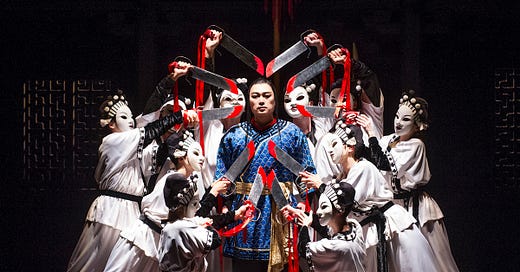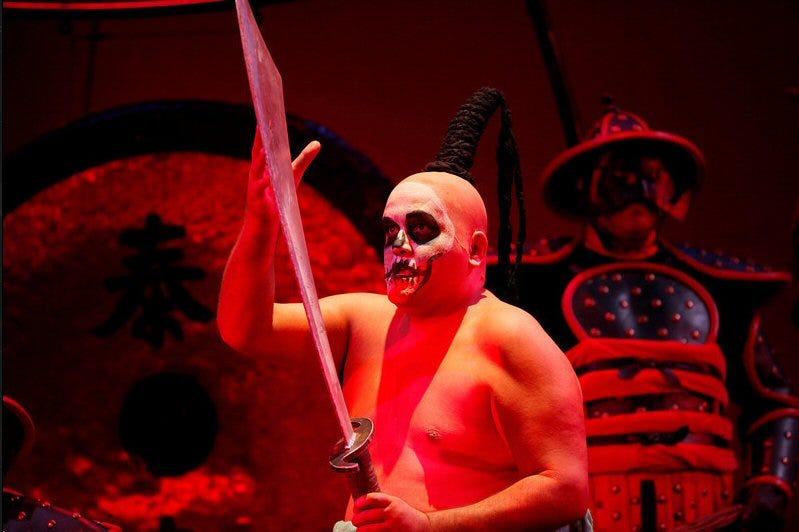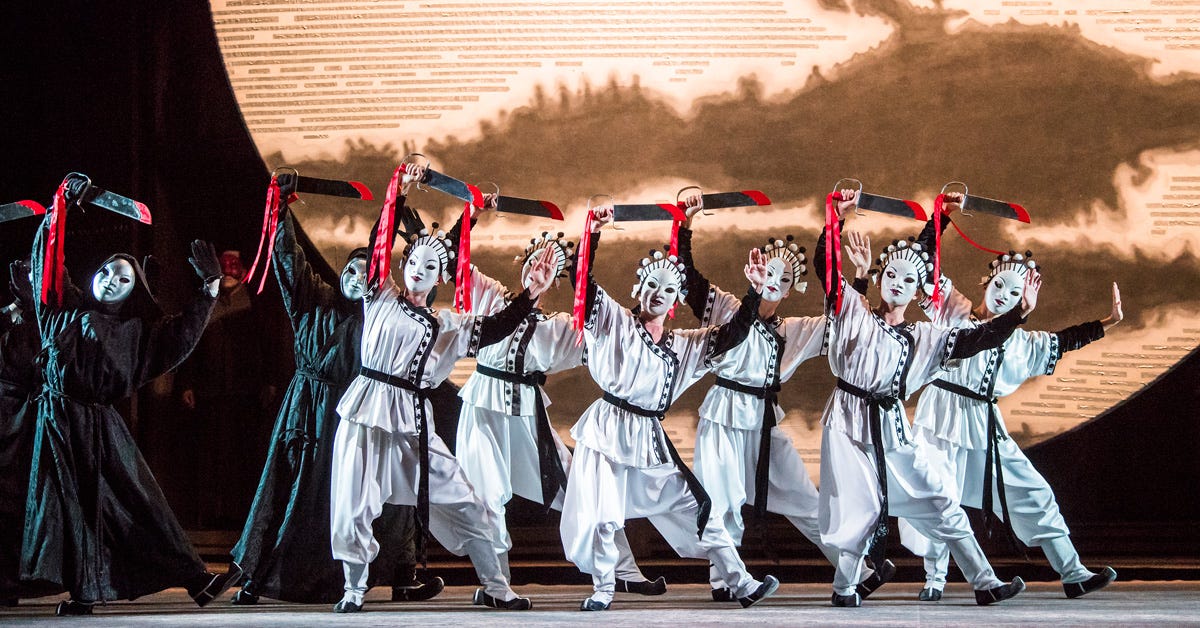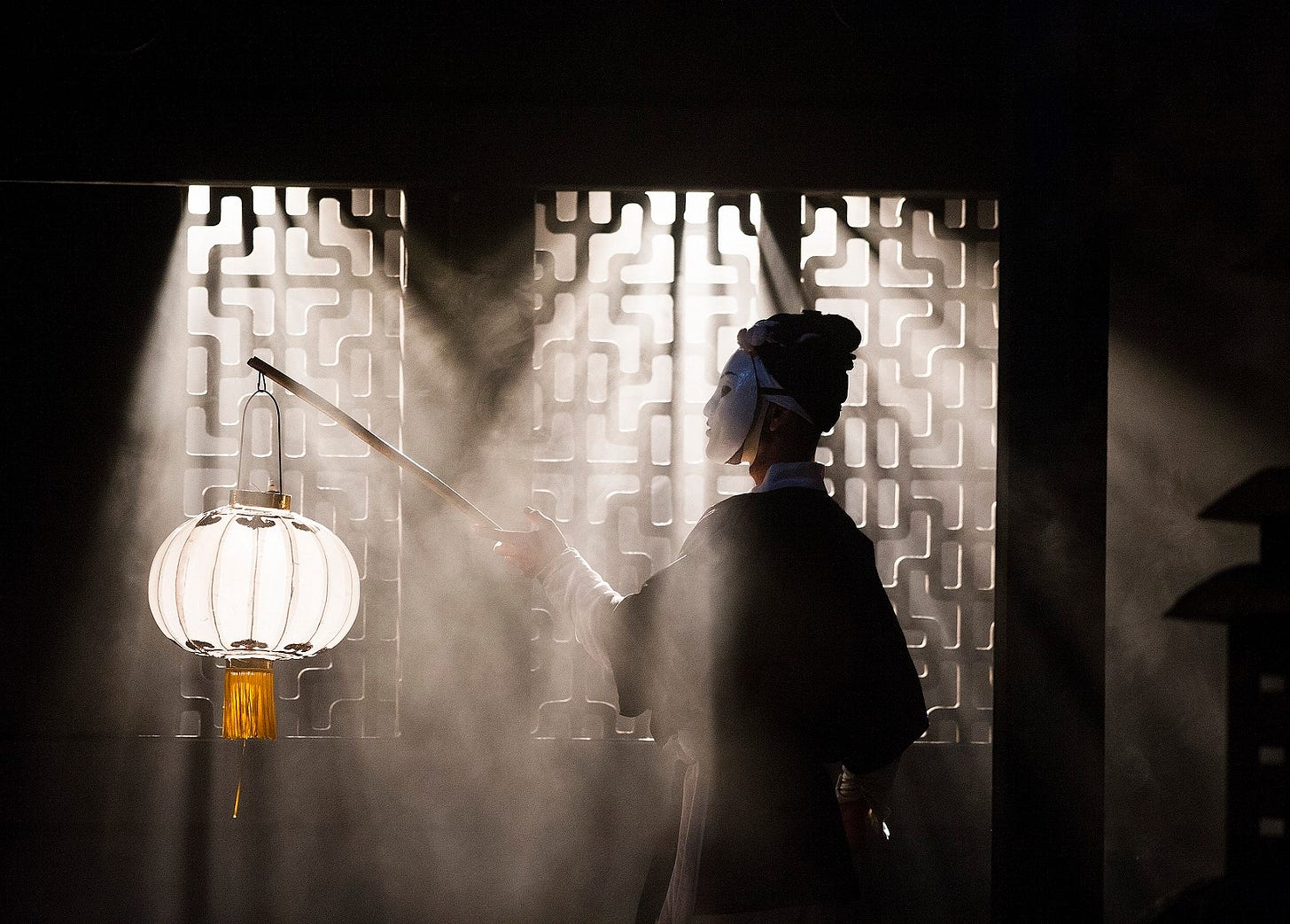Folk Horror, Public Execution, and Mob Violence in Turandot
Horror Moments, Opera Edition
‘Horror Moments’ is a weekly series examining horror-inflected scenes and themes in unexpected places. The ‘moments’ are published weekly on Thursdays, and I share articles on the history of magic, theatre, storytelling, and more on Mondays. Catch up with the recent Kate Bush series here and the full back catalogue of horror moments (from Wallace & Gromit to Shakespeare) here. Don’t forget to subscribe!
Sometimes, the most frightening monster is a crowd of human beings. This week we explore how the horror of mob violence is captured in Giacomo Puccini’s Turandot. Did you know this opera before beginning this article? Is it brand new to you? What other stories do a good job of capturing this theme? Let me know what you think in the comments.
A Public Execution
Three strangers have arrived in an unhappy city. They pass as beggars, mingling with the crowds who seem indifferent to their plight. There is a strange tension in the air, the people quiver with sadistic anticipation: something horrible is about to happen.
Suddenly, it all brims over and the crowd bursts out as one, a carnivorous entity lusting after violence:
‘Turn the grindstone, grind, grind, grind, grease and sharpen the blade, let it spit fire and blood.’
We are in Peking (Beijing), the realm of the beautiful but deadly princess Turandot. She has vowed never to marry unless a suitor can solve her impossible riddles. The punishment for failure is death, but men can’t seem to stop themselves from trying. The crowd gloats:
‘Gentle suitors come, with our hooks and knives we shall embroider your skin.’
How very Hellraiser.
After the frantic exposition the music suddenly calms and becomes, somehow, far creepier. The crowd is still singing, but their melody is eerily beautiful. They are waiting for the moon to rise, when the executioner Pu-Tin-Pao will behead the latest victim, the Prince of Persia. They are all completely transfixed, poised, like a predator about to pounce, their breath is held:
Why does the moon tarry?... oh severed head, oh bloodless one…the graveyards impatiently wait your funereal gleam…
When the moon finally appears, they cry out ecstatically as one,
Pu-Tin-Pao! The moon has risen!
Incidentally, the resemblance of this name to ‘Putin’ was slyly signalled by Ukrainian singer Lyudmila Monastyrska when she wrapped herself in her country’s flag to take her curtain call after playing Turandot at the Metropolitan Opera. She had replaced Russian soprano Anna Netrebko who was dropped by the Met after her refusal to denounce Putin. Who says old operas can’t be political?
Anyway, to return to the execution scene, the crowd who has been lusting for blood undergoes a sudden transformation when the unlucky Prince of Persia is brought before them. Struck by how young he is, the fickle mob changes sides and starts to beg the princess to spare his life. She refuses.
His final word is ‘Turandot!’ and then, with a shriek from the crowd, the axe blade falls.
The Horror of Folk
I’ve always thought that the thing which really makes the ‘folk horror’ subgenre scary is not the writhing roots and creepy hares, nor even the trappings of pagan ritual, but the terrifying reality of what humans are capable of doing when they act together as a group. It is all about the horror of the ‘folk,’ the breakdown of social norms or the presence of social structures that permit horrific violence.
Antonio Pappano (conductor at the Royal Opera) points out that Puccini described Turandot as a fable and says it’s ‘about ritual and old traditions and old scores to be settled.’ Under Turandot’s cold reign, the people of Peking (the first line of the opera is ‘People of Peking!’) have grown cruel.
The story comes loosely from the twelfth century Persian poet Nizami Ganjavi who wrote about a similar princess in Russia (Russia again!) It comes to Puccini in Italy via the 1722 collection The Thousand and One Days: Persian Tales by François Pétis de la Croix, where supposedly Middle Eastern folk tales were retold for European audiences (many made up or embellished by de la Croix.)
Here she is reimagined as Turandokht, a Chinese princess. So the setting of the play is essentially ‘a cold, imperial, brutal Other’ rather than a realistic depiction of China. This hasn’t stopped a lot of productions from continuing to use orientalist tropes and it’s still hard to find a version that isn’t distractingly insensitive to East Asian audience members. Opera has been a lot slower than other types of performed storytelling to modernise its attitude towards race.
This version is a modern reimagining that draws on sci fi, Turandot by way of…Star Trek? which doesn’t entirely work – but at least it’s not yellowface:
If we abstract the story from a particular setting the folk horror themes become starker. It doesn’t really matter which country we’re in, the problem is that we are outsiders, and that the people of this place are not our friends.
Lest we forgive the mob who seemed to find mercy in their hearts at last for the Prince of Persia, another scene towards the end of the opera makes clear that the whims of this crowd are fickle, and their fury is just as vicious as ever.
When our hero, Prince Calaf, successfully solves the riddles, Turandot is furious. She wants to remain a virgin, she carries the inherited trauma of an ancestor who was raped and murdered by a foreign prince. Calaf gives her a riddle of his own: if she can guess his name by morning, he will release her from the obligation of marriage and she can execute him at dawn. The Princess vows to lay waste to the land and massacre the population if that name cannot be discovered. No one will sleep that night (this is where “Nessun dorma” comes from!)
The frantic mob turns on Liù, the serving girl who has accompanied Calaf and his father on their wanderings. She has always loved Calaf and would do anything for him, even lay down her life.
So guess what happens to Liù? The crowd calls for Pu-Tin-Pao to torture her. She resists and resists as long as she can, refusing to speak, saying that love gives her the strength to endure – something Turandot doesn’t seem to understand.
There’s a spine-tingling scene where she sings her final lines. She sounds feeble, Puccini lets the weariness and pain seep from each note, and then, in a sudden burst of resolve and courage, she grabs a dagger from a soldier’s belt. By the time the mob notices, it’s too late, she dies with their screams of ‘his name his name’ ringing in her ears. And then there’s a bit where Calaf’s elderly father, who is blind, finds her on the floor and thinks she’s asleep and sings for her to wake up and cries out in horror when he realises she’s dead and cradles her body — it’s so so sad!
The End of the Opera
Something happens to the opera with the death of Liù. The heart goes out of it, the story feels suddenly low-stakes. Who cares what happens to Turandot, to Calaf, to these horrible fickle people? How is any of this supposed to be resolved when death and marriage are equally as horrid to the princess?
There is a happy ending. The Prince kisses Turandot and she realises she actually does love him and then he tells her his name and she decides not to kill him after all…
Puccini didn’t write this ending, he had written as far as Liù’s death before getting stuck and he died with the rest unfinished. Franco Alfano had the unenviable task of tying together this unwieldy melodrama and he was chided for trying to add his own spin on Puccini’s sound.
When the opera premiered in 1926 at La Scala, it finished with the end of Puccini’s music and the conductor Arturo Toscanini turned to the audience and said words to the effect of ‘the opera ends here because Puccini, its composer died.’ I’d kind of love to see this version, not because Alfano didn’t do a good job with the ending, but because it feels as if the story dies with its most important character, Liù.
Turandot is a strange piece of storytelling and taken as a whole there are many things that make it difficult to process, from the treatment of its East Asian setting to its attitude towards female sexuality. It’s got some of Puccini’s most spectacular music and it’s an opera I can listen to again and again, but perhaps I’m drawn to it because, at heart, it is a story about love and cruelty framed with the frightening folk horror spectre of a chorus-turned-mob.
Next week we turn to a much less well-known opera to explore what happens when you sing a seance. Until then, happy nightmares everyone!
Horror moments are posted every Thursday and a wide variety of articles exploring the history of magic, theatre, storytelling, and more are published on Mondays.
Remember that you can pay to subscribe for extra benefits or buy me a coffee here to keep me writing. You can also like, share, comment, and recommend to help the substack grow. Thank you!








I knew the name of this opera, but nothing about the story. Absolutely fascinating, thank you, Rebekah!
I read this days ago but since switching to email I understand now why so many people read stuff without interacting on the platform--long story short I've been meaning to comment and say I'm really enjoying your insight into opera and am learning a lot about its range! I also recently read Bel Canto by Ann Patchett which gave me a small burst of motivation to listen to more opera which has since faded but in any case perhaps the seed is planted...